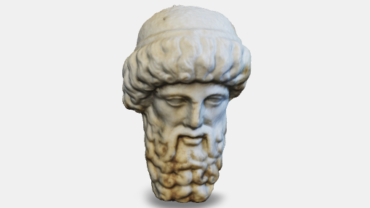
Discovered among the ruins of the Villa of the Pisones, not far away from Punta Epitaffio, this lead water pipeline allowed for identifying the owners of the entire complex: the inscription on the artefact “L. Pisoni” allows us, in fact, to identify the submerged remains…

Found in the waters of the port of Baia among the sunken remains of the imperial Palatium, this little herm show evident signs of exposition to the underwater environment, as shown by the numerous holes dug by lithodomes in the beard. A Roman copy of…

Perhaps part of a herm, the sculpture was found in the waters of the port of Baia among the remains of the submerged imperial palace. Of a relatively late production, the head was perhaps inspired by the type known as Hermes Propylaios by Alcamenes. The…

Discovered in the basin of the ancient port of Misenum, this fragment of trabeation with a decoration was certainly a part of a public building of a significant size, probably in the centre of Misenum, of which today only a few traces are visibile (Bath,…

Discovered in the waters of the ancient port of Misenum not far away from Punta Terone, the large inscribed pedestal, damaged by a long permanence in water, contained a dedication by the collegium of fresh fish sellers to Caius Julius Maro, a veteran of the…

Strongly damaged by lithodoms in the upper part, the pedestal was discovered in the XIX century in the waters of the Ripa Puteolana and bears an inscription dedicated to the emperor Hadrian from the residents of a vicus called Lartidianus. The said vicus had to…

This large altar in white Carrara marble was discovered in 1965 in the waters of the quay of Ripa Puteolana. It was topped by sacred Betyls and characterized by a large inscription dedicated to the god Dushara, and it constitutes – along with slabs and…

Amphora Dressel 6A with stamps CA^DMI e RUBRI. Intact. Wine amphora characterised by a long cylindrical neck, a slightly carinated shoulder and two vertical, oval-section handles. Ovoid body ending with a foot. Collared rim. Its underwater origin is not verifiable. The amphora is to be…

An intact amphora of Corinthian B type, Greek-Siceliote production. Rim with an echinoid band. Tall neck from which the handles ramify just below the rim. Globular body, tending towards biconical. Bottom with a short, truncated foot. The Corinthian amphorae were introduced into a large part…

Wine amphora made in the Eastern Mediterranean. Biological degradation The amphora presents an epilithic colonisation almost on the whole surface. Particularly relevant are thalli of encrusting red algae (visible as a hard, whitish patina). Moreover, there are present also colonies of Bryozoa and encrusting tubes…

Bronze lump of a rectangular, rounded shape and a plane-convex section. Ongoing investigations, focused mainly on the unit of weight measurement, may lead to its dating to the Bronze Age. Close to the site, a stone anchor of a truncated-pyramidal shape was found: perhaps it…

Spheroidal stone projectile. Belonging to a petrary or a small bombard. These projectiles were mostly used with heavy breechloaders in wrought iron. Biological degradation No traces of biological colonisations are visible. References


